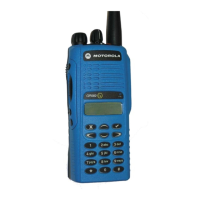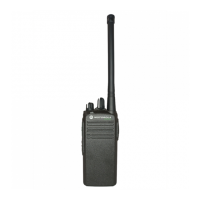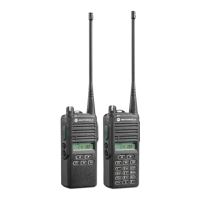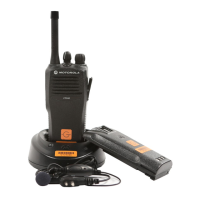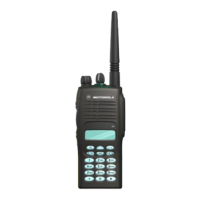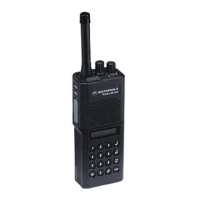Radio Programming and Tuning: Receiver Tuning 5-9
x. Filter 2: 15 kHz LPF
xi. Ext Load R: 24 Ω
2. Initial setup using the R2600 series RF Communications Test Set
a. Connect “RF IN/OUT” port on R2600 series to RF adaptor on radio’s antenna port using a N-
Type to BNC cable. Connect “VERT/SINAD DIST/DVM COUNTER IN” on R2600 series to
the single input on audio transformer using one BNC to BNC cable. Connect the rest
according to Figure 5-6. Radio Tuning Setup.
b. On R2600, select “DISP” under “CURSOR ZONE”
i. Meter: SINAD
ii. Mode: STANDARD
c. On R2600, select “RF” under “CURSOR ZONE”:
i. RF Control: GENERATE
ii. Preset: --
iii. B/W: NB
iv. Freq: Frequency Point (F1–F5) on Tuner
v. Output Lvl: -128dBm (refer to step 2 in Section 5.6.2) and increase slowly (-127dBm,
-126dBm…) (refer to step 3 in Section 5.6.2)
vi. Gen RF Out: RF I/O
vii. Modulation Type: FM
d. On R2600, select “AUD” under “CURSOR ZONE”:
i. Fixed 1kHz: 1.50 kHz for 12.5kHz channel spacing and 3.0 kHz for 25kHz channel
spacing. Enable (~)
ii. Synth: Disable (x)
iii. DTMF: Disable (x)
iv. External: Disable (x)
5.6.2 Receive 12.5 kHz-Band Normal Squelch Tuning
1. Under the Alignment menu, select Rx Squelch, then select Squelch 12.5 kHz-band Normal.
(Figure 5-11. Rx 12.5 kHz-band Normal Squelch Tuning Window).
2. Apply a RF signal (with 1 kHz tone at 1.5 kHz deviation) for current frequency point with minimum
amplitude, -128 dBm (F1 being the first).
3. Set softpot to minimum (0) and adjust the amplitude of RF signal to the range of normal squelch
tuning (as shown in Table 5-8.) on the test equipment.
4. Adjust the softpot value by using either the Left/Right arrows on the slider or Up/Down arrows on
the Working Softpot box until the radio is totally muted.
5. Repeat steps 2–4 for F2–F5.
6. Press Program to commit the softpot values into the codeplug.

